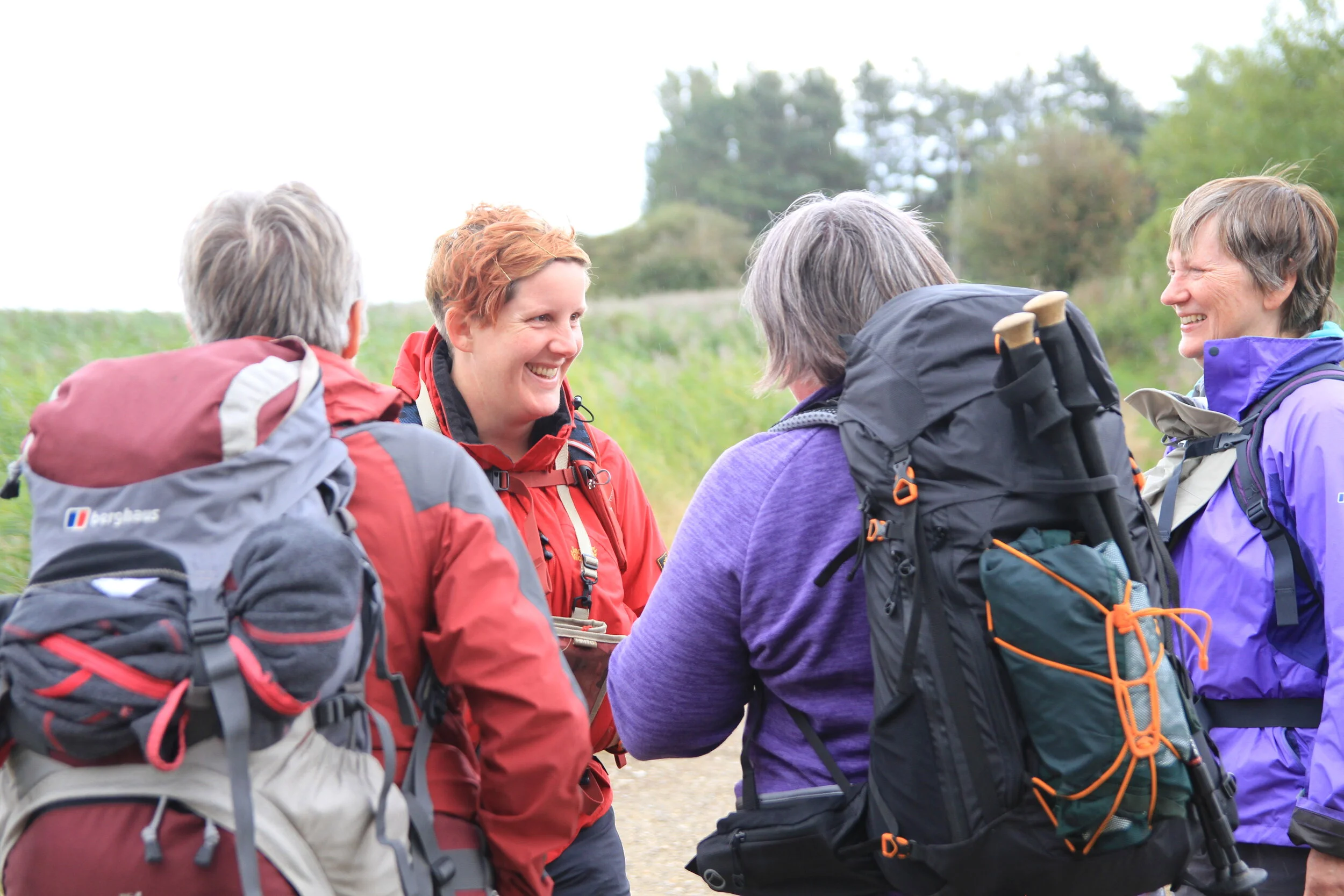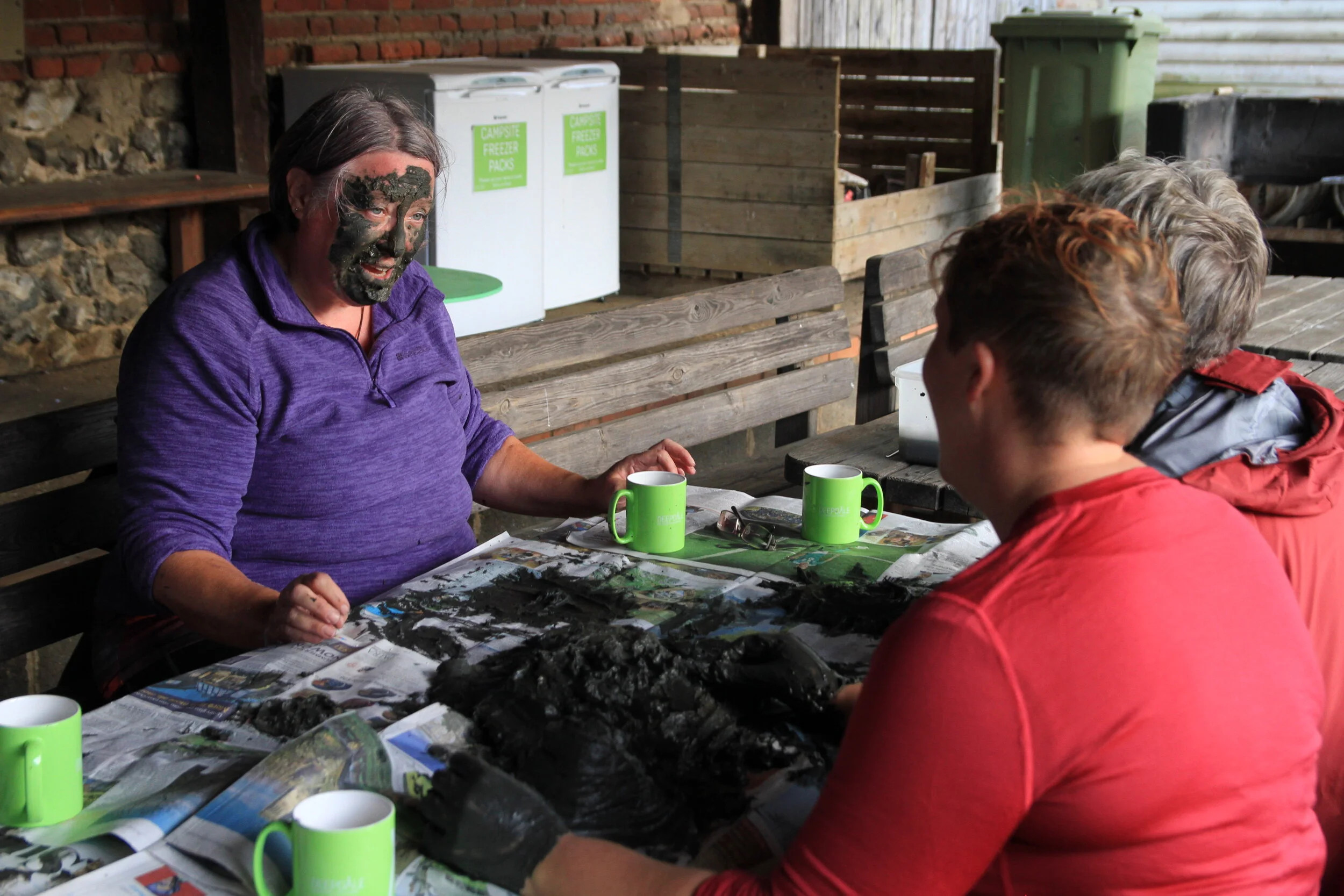landscapes and meaning 2
so what do you actually do, then?
On ipse wilderness journeys, I lead groups of adults on 3- or 4-day wilderness well-being walks in different areas of the UK. I plan the route in advance so that we extract metaphors of the landscape and use them as a way into sharing about emotional and psychological issues. Invitations are made to reflect on our intellectual, physical, spiritual and emotional well-being via metaphorical connection to the landscape. So we are walking and talking, speaking about topics linked to the landscape we are walking through. Thus, not only are we benefitting from the physical exercise, time spent outdoors and the therapeutic effect of green environments, but we are also being guided in gentle self-reflection in a way which attunes us to the natural world, whilst participating in a community built on openness, trust and shared endeavour. Each journey has an over-arching theme so that its structure takes participants towards a sense of completeness, satisfaction and empowerment. Overall, ipse wilderness journeys are facilitated therapeutic pilgrimages, encouraging people to journey inside, outside.
but, like, what does that actually mean?
It means that on each day of a 4-day walk, there are roughly 10 scheduled ‘invitations’ or activities, each of which takes place at a specific point along the route. Some will be solo activities; suggestions just to walk on, silently reflecting on a certain topic. For example, having come to a crossroads, participants might be invited to reflect on a time in their lives when they faced a turning point, and to recall the decision they made and how it felt at the time. Other activities will be pair exercises. The group will walk on and participants will pair up and take turns to speak about the topic that has been raised. The listener will simply listen and give some feedback, before swapping over and taking their turn to share. The topic here might be inspired by, for example, a set of stepping stones; what are the steps you have taken that have got you to this point in your life? At other times, the activity will be a more extended group exercise. We might all stop and circle up, to discuss a particular topic such as, inspired by a boundary footpath, the question of how we set boundaries in our lives. At other moments, there might be a game, an activity, a challenge or simply space for meditation and rest. The trajectory of the whole day is carefully curated, and in between invitations, there is ‘down time’ simply to walk and chat, follow one’s own pace or continue the conversations that have been enjoyed.
ok, so can you give some more examples?
Sure! This is the second in a series of 4 blog posts, cataloguing some of the common features of walks, and suggesting some simple invitations of topics to examine whilst experiencing these features. Since I couldn’t think of a more straight-forward way to arrange these ideas, they are listed in alphabetical order, so this blog post will deal with G-L. Click here to read the first post covering A-F.
gates
Gates can be a reassuring touch-point with the map or directions on a walk, a fiddly annoyance, or a welcome excuse for a short pause. They can gather the group together again, as the front walkers grapple with the latch, and the rear guard simply turn and slam. Gates can be interesting in their construction, unique in their placement and can have engaging inscriptions or stories attached.
metaphor
The countryside code states that we must leave gates as we find them, whether open or closed. This is a pleasant reminder that however you are is OK. No need to be more, do different or change anything. You are perfect just as you are. You could simply draw your attention to your ‘gait’. How are you walking, both physically and emotionally? How do you travel through life? And let the answer be OK, whatever it is.
invitation
Use gates as excuses on a walk; to rest, to connect or to just be. At a kissing gate, why not make it a family tradition to kiss the next person in your group as they go through the gate? Or pay a compliment to each person as they pass? Or share a story about a great kiss you once received!? Tapsel gates are a type of gate hinged in the middle, so it swings on a central axis and walkers can pass through on both sides. This makes for a perfect invitation to pair up and share. Or to reflect on a duality present in your life. Or make a promise to yourself to stop for just a moment at every gate on a walk. Just lean, rest, breathe and be. You are enough.
I could happily lean on a gate all the livelong day, chatting to passers-by about the wind and the rain. I do a lot of gate-leaning while I am supposed to be gardening; instead of hoeing, I lean on the gate, stare at the vegetable beds and ponder. Tom Hodgkinson
holt/halt
I was born and spent my childhood in a town called Holt, and we were taught that the word meant a wooded hill. I enjoy the homophone of holt and halt, and few places are as pleasant to stop and enjoy a break on a walk than a wood, especially if one has been climbing uphill to reach it.
metaphor
Woods can be ancient and seem timeless; they stood before us, and will outlast us. Tree planting is a promise to the future and an exercise in hope. Woods remind us to take our time.
invitation
Call a halt in a holt. Lean against a tree, close your eyes and listen to the wind in the leaves. Or look up and enjoy the interlocking canopy. Or down and notice the litter and detritus as it returns to the earth. Have a picnic, play hide and seek, or identify some trees by their leaves. Take your time in the woods, and think of all those who have taken time there before you, and who will visit there after you.
On Wenlock Edge the wood's in trouble;
His forest fleece the Wrekin heaves;
The gale, it plies the saplings double,
And thick on Severn snow the leaves.
'Twould blow like this through holt and hanger
When Uricon the city stood:
'Tis the old wind in the old anger,
But then it threshed another wood.
Then, 'twas before my time, the Roman
At yonder heaving hill would stare:
The blood that warms an English yeoman,
The thoughts that hurt him, they were there.
There, like the wind through woods in riot,
Through him the gale of life blew high;
The tree of man was never quiet:
Then 'twas the Roman, now 'tis I.
The gale, it plies the saplings double,
It blows so hard, 'twill soon be gone:
To-day the Roman and his trouble
Are ashes under Uricon.
‘On Wenlock Edge’ by A. E. Housman
islands
I am obsessed with islands. I wrote my MA thesis on the relevance of islands in literature and have A LOT to say about them! Islands in fiction are widely used as metaphors for self-discovery and identity. And in real life, I love nothing more than a visit to an island. In Nicaragua I once visited an island on a lake on an island on a lake and I thought I’d died and gone to heaven.
metaphor
An island is a spot of land where we can be isolated and cut off. It’s at once liberating and somewhat alarming. We are free but may be forgotten. How then do we remain in touch with the world? In fiction about islands, characters invariably seek to place themselves inside a larger pattern; to find an object or creature smaller than themselves, in order to get back into hierarchy, and remain connected to the systems of culture. Robinson Crusoe used his date stick. Pi trained the tiger. Jack and Ralph bullied the littluns.
invitation
Explore your relationship with islands. Whether you set foot on a duck island in an ornamental lake, circumnavigate one on a remote journey, or just take a moment to appreciate that you live on an island(!), it’s interesting to connect with that tension between freedom and loneliness. You may feel cut off, but underneath the water, at the base of it all, we are all connected. Turn inwards and consider how you relate to yourself and to the world. What is the shape of your I-land?
No man is an island entire of itself; every man
is a piece of the continent, a part of the main;
if a clod be washed away by the sea, Europe
is the less, as well as if a promontory were, as
well as any manner of thy friends or of thine
own were; any man's death diminishes me,
because I am involved in mankind.
And therefore never send to know for whom
the bell tolls; it tolls for thee.
by John Donne
jungle
I’ve been lucky enough to spend time trekking in some of the planet’s amazing jungles. Lush, tropical and humid, jungles are intense and extraordinary places, where the cycle of life is very much on the surface. You can watch organisms decompose in real time, and see armies of ants carry off dead insects right under your nose. Poisonous plants, venomous invertebrates and carnivorous mammals are all clamouring for your blood, in the case of leaches, quite literally. Real jungles are uncomfortable places, and I have often felt thankful for the ‘friendliness’ of the UK’s woods and forests where nothing is trying to eat me!
metaphor
A jungle is a web of interconnected organisms; a whole network of life and death and a great reminder of the vibrant, passionate, chaotic dance of life. The tangled branches, wild thickets or mossy creepers of our British woodlands can sometimes be a portal into the jungle psyche; a simple gateway into feeling lost, free and wild and an invitation to explore and surrender.
invitation
It can be a powerful experience to choose this environment deliberately; to take oneself to the jungle in order to get lost. To surrender to the wild, tangled mess and twisting paths of a complex eco-system, even if it’s just our local woods. Play ‘left, right’ or ‘the road less travelled’ or whatever spur of the moment game keeps you on your toes guessing which way to go only at the last minute. Spin around, walk with your eyes closed, or get on your hands and knees and experience this jungle as an insect might. Go feral. Why not?
The jungle is dark but full of diamonds. Arthur Miller
kestrel
A kestrel is a type of falcon, a bird of prey known for its skill in hovering. In fact, the old name for a kestrel was a windhover, alluding to its habit of facing into the slightest breeze to maintain a hover, and near me is a hill called Windhover Hill.
metaphor
Gerard Manley Hopkins’ poem ‘Windhover’ is an expression of rapture at the kestrel; a love song about a dawn awakening and a recognition of the joy and insight into life that intense identification with nature can bring. It’s full of gasping breathless wonder at the movement, speed, shape, colour, majesty of the kestrel, and sees that even the humblest of nature’s elements, mud and ash, are miraculous. The poet’s conclusion is that nature is to be worshipped as his ‘chevalier’ or knight.
invitation
When you spot a bid of prey, or any striking creature, take time to just observe and wonder at it. Or on a walk, share with a friend a time when nature has unlocked joy or insight for you.
I caught this morning morning's minion, king-
dom of daylight's dauphin, dapple-dawn-drawn Falcon, in his riding
Of the rolling level underneath him steady air, and striding
High there, how he rung upon the rein of a wimpling wing
In his ecstasy! then off, off forth on swing,
As a skate's heel sweeps smooth on a bow-bend: the hurl and gliding
Rebuffed the big wind. My heart in hiding
Stirred for a bird, – the achieve of, the mastery of the thing!
Brute beauty and valour and act, oh, air, pride, plume, here
Buckle! AND the fire that breaks from thee then, a billion
Times told lovelier, more dangerous, O my chevalier!
No wonder of it: shéer plód makes plough down sillion
Shine, and blue-bleak embers, ah my dear,
Fall, gall themselves, and gash gold-vermilion.
‘The Windhover’ by Gerard Manley Hopkins
liminality
The verb ‘to limn’ means to outline, giving us the word liminality to describe the concept of an edge or shoreline. Sociologists use the term liminality to describe the uncertain space between two states. Human societies tend to create rituals to get us over these difficult liminal spaces; graduation, engagement, and rites of passage all help people to transition from one phase of life to another.
metaphor
A liminal space occurs at edges; the shifting sands between the sea and the land, the mudflats between the water and terra firma, the foothills between the plain and the mountains. These spaces are potentially uncertain and unsettling, raising the possibility of change and characterized by flux and transition.
invitation
Walk along the edges. Paddle in the water. Dip your toes in the unknown. Get comfortable with the uncertain. One medium which perfectly symbolises liminality is mud and it can be amazingly liberating to get in touch with mud. It is mutable and unstable, neither earth nor water, it is made from decay but also breeds life. Play with this element as we once did as children. Stomp through the mud. Take your boots off and squelch your toes in it. Make mud pies. Make a face mask. Have a mud fight. Get muddy. And notice how it feels to get comfortable with discomfort.
We are animal in our blood and in our skin. We were not born for pavements and escalators but for thunder and mud. More. We are animal not only in body but in spirit. Our minds are the minds of wild animals. Children know it as magic and timeless play… What is wild cannot be bought or sold, borrowed or copied. It is. Unmistakeable, unforgettable, elemental as earth and ice, water, fire and air, a quintessence, pure spirit, resolving into no constituents. Don't waste your wildness: it is precious and necessary. From ‘Wild’ by Jay Griffiths
Next time you go for a walk’n’talk, why not reflect on unusual topics via metaphorical connection to the landscape? Journey inside, outside by suiting your conversation to the features you see, making use of nature as a mirror; a way in to greater understanding of yourself and your companion.
And do get in touch if you fancy seeing how all this works on a real ipse wilderness journey!





